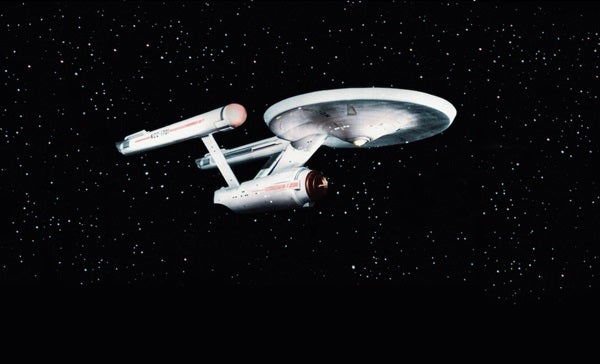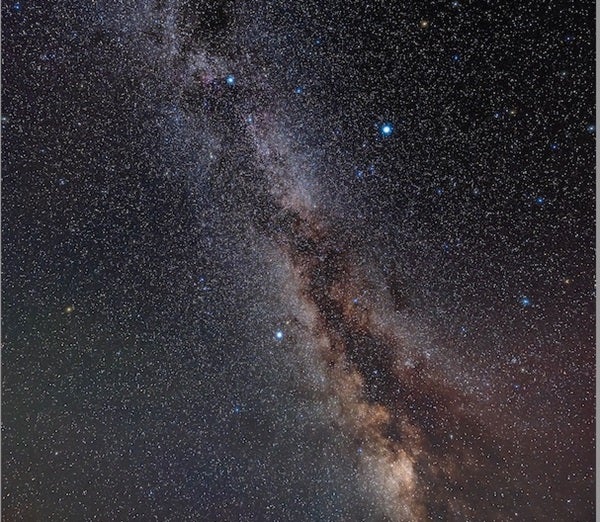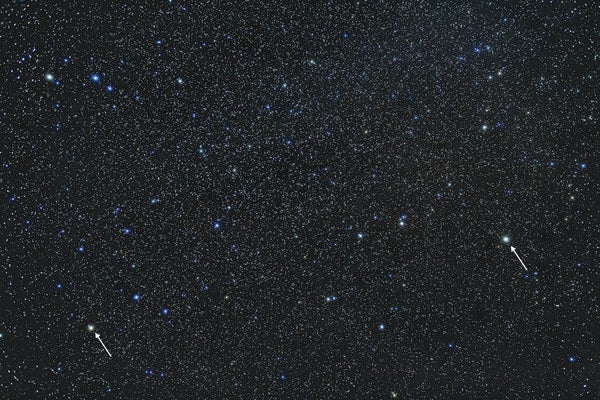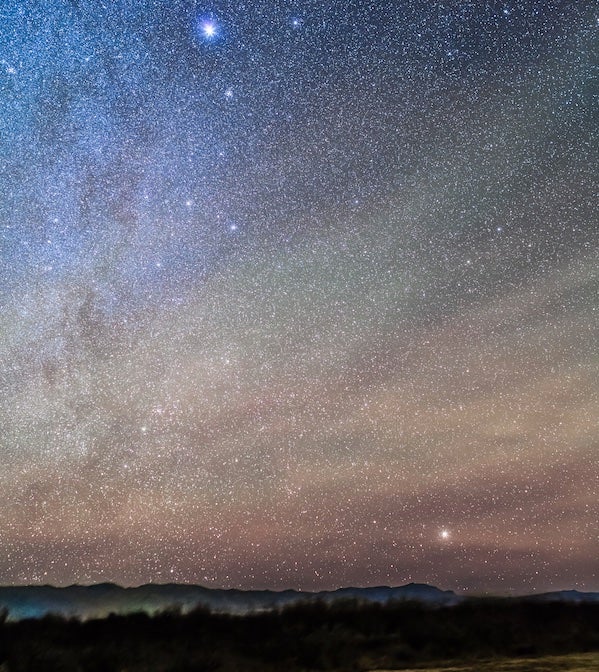By far, however, the TV show that gave the most astronomy buffs their start exploring space was Star Trek, which began a three-season run at 8:30 P.M. EDT on Thursday, Sept. 8, 1966. This groundbreaking television show was followed by Star Trek: The Next Generation (1987), Star Trek: Deep Space Nine (1993), Star Trek: Voyager (1995), Star Trek: Enterprise (2001), Star Trek: Discovery (2017), and Star Trek: Picard (2020), along with various movies, animated series, and lots of books and comics.
During the five and a half decades that followed the first show, now often referred to as The Original Series, the Enterprise has visited hundreds of planets. Of course, each one originated in some writer’s imagination. But I wondered how many of those destinations were placed in a star system visible in our sky. A lot, it turns out. I stopped counting at 50.
What follows is a list that combines some of the brightest stars in our sky with several not-so-bright ones, all of them important in the Star Trek universe. The next time you look at one of these stars, let your mind drift back to 1966, when people — through their television sets — voyaged to distant worlds. Indeed, with all the recent exoplanet discoveries, it’s not hard to imagine that an alien civilization might exist where no one has gone before, on a planet revolving around one of the stars of Star Trek.
Strange new worlds
Besides Earth, probably the most important planet in Star Trek is Vulcan, homeworld of Mr. Spock. Early on, some official reference books listed magnitude 3.7 Epsilon (ε) Eridani as the star around which it orbited. During an episode of Enterprise, however, Chief Engineer Tucker states that Vulcan is 16 light-years from Earth. And Epsilon Eri is only 10.5 light-years away.
Current Trek star maps place Vulcan in the Omicron2 (ο2) Eridani system. This triple star, also known as Keid and 40 Eri, is some 16.3 light-years from Earth. Its primary glows at magnitude 4.4. To find it, look 15° west of Rigel.
The brightest star visited by any Star Trek crew on television or film is Canopus (Alpha [α] Carinae), which observers can spot from the southernmost states. Shining at magnitude –0.7, it’s the second-brightest star in our night sky. It featured in The Original Series episode “The Ultimate Computer.” In the episode, which takes place in 2268, the scientist Richard Daystrom installs a tactical computer aboard the Enterprise. The device can control the ship with some 5 percent of its normal crew. Its first task is to survey the inhabited planet Alpha Carinae II.
Note that the brightest nighttime star, Sirius (Alpha Canis Majoris), also has a planetary system whose members served as settings for stories, but only in Star Trek books or video games.
The third-brightest star in our sky, Alpha Centauri, is a triple system that’s famous as the nearest star system to our own. It’s also famous in the Star Trek universe, hosting no less than 22 planets. Thirteen of them circle Rigil Kentaurus (Alpha Cen A), five orbit Alpha Cen B, and four more travel around Proxima Centauri (Alpha Cen C).
What’s more, three of these planets are populated. Including outposts and space stations, this system supports some 21 billion inhabitants. When you spot Alpha Centauri (only visible from latitudes south of 30° north), imagine how cool it would be if, in reality, any planets around those stars contained the simplest form of life, let alone intelligent life.
Our next entry is one that requires some searching to see. In the Star Trek universe, more than 150 planetary civilizations belong to a democratic society known as the United Federation of Planets. Such a body often needs neutral ground for negotiations: a planet named Babel, which orbits the star Wolf 424.
This star, also known as FL Virginis, is a system of two red dwarfs a bit more than 14 light-years away that together glow just brighter than a meager 13th magnitude. You’ll need an 8-inch or larger scope, a dark site, an excellent star chart (or software), and lots of patience to track it down. But for a true fan of Star Trek, that’s a small price to pay to spot a star whose planet has two episodes — “Journey to Babel” and “Babel One” — named for it.
The stellar moniker Menkar may not be familiar to Star Trek fans. But call this star Ceti Alpha, and it will immediately conjure up the image of Khan Noonien Singh. This character first appeared in The Original Series episode “Space Seed,” and then in the movies Star Trek II: The Wrath of Khan and Star Trek Into Darkness.
Though referred to in Star Trek as Ceti Alpha, a luminary that has at least six planets in orbit, it’s more correct to call this star Alpha Ceti. However, Star Trek’s writers aren’t the only ones to break convention regarding the star’s designation. The alpha star is usually the brightest star in a constellation. Not in Cetus the Whale, though. That honor goes to Diphda (Beta [β] Ceti), which, at magnitude 2.0, is 58 percent brighter than magnitude 2.5 Alpha. Both stars are easy to spot in the Northern Hemisphere’s autumn sky.
Three to beam up
A triad of stars well known to amateur astronomers is the Summer Triangle: Vega (Alpha Lyrae), Altair (Alpha Aquilae), and Deneb (Alpha Cygni). In Star Trek, Vega hosts at least nine planets, the main one being Vega IV with a mostly human colony of nearly 5.8 billion inhabitants. This system is referenced in The Original Series episode “Mirror, Mirror.” Captain James T. Kirk learns that one of the first actions his mirror counterpart took after assuming command of the Enterprise (via assassination) was to execute 5,000 colonists on Vega IX.
Now, on to Altair. The most famous planet in the Altair system is Altair VI. In The Original Series episode “Amok Time,” the Enterprise is headed to this planet to attend the inauguration of its new president when it has to divert to Vulcan for Spock’s mating ritual.
In Star Trek, the name Deneb is used to refer to the “true” Deneb (Alpha Cygni) and also as shorthand for Deneb Kaitos, which is another name for the star Diphda in Cetus. The latter has no less than six planets, while the former hosts nine planets, the most important of which are Deneb II and Deneb IV. This second world is the site of Farpoint Station, where the crew in the very first The Next Generation episode, “Encounter at Farpoint,” meets the ultra-powerful being known as Q.
Tribbles, the Borg, and Denobulans, oh my!
Midway on the sky between the Andromeda Galaxy (M31) and the Pleiades (M45), you’ll find the tiny constellation Triangulum. Of its three brightest luminaries, the least apparent is 4th-magnitude Gamma (γ) Trianguli. In The Original Series, the Enterprise visited the planet Gamma Trianguli IV during the episode “The Apple,” finding a civilization controlled by a supercomputer named Vaal.
Every Star Trek fan — and probably most non-fans — have heard of Tribbles, which debuted in “The Trouble With Tribbles” in the second season of The Original Series. Brought aboard the Enterprise by merchant Cyrano Jones, they nearly overwhelmed the ship’s operations. The homeworld of the furry creatures is Iota Geminorum IV, whose central star, Iota (ι) Geminorum, glows at magnitude 3.8 about 4.5° from both Castor and Pollux.
On the other end of the brightness spectrum from most of the stars I’ve mentioned, Wolf 359 is incredibly faint. Although it lies less than 8 light-years away, this red dwarf glows meekly at magnitude 13.5. Wolf 359 lies in southern Leo, almost directly on the ecliptic. In The Next Generation two-part episode “The Best of Both Worlds,” a disastrous battle takes place in this star system between the Federation and the Borg. The real kicker is that the Borg ship is under the guidance of Locutus — formerly the Enterprise’s Captain Jean-Luc Picard, who was captured and assimilated into the Borg collective, losing his individuality and prior allegiance in the process.
Only an observer familiar with the series Enterprise will know the planet Archer IV, named for the captain of the NX-01. It’s an important one, however: the first M-class (meaning Earth-like and habitable) planet discovered by humans. To see the luminary around which this fictional world revolves, look toward the southernmost part of the constellation Ursa Major. There, you’ll find the Sun-like star 61 Ursae Majoris, glowing at magnitude 5.3 — just bright enough to spot without binoculars from a dark site.
Enterprise also gave us the wonderfully named Denobula Triaxa, the star we know as Iota Boötis. In fantasy, this is a triple star, but reality shows it is binary. Its components glow at magnitudes 4.8 and 8.3. You can spot them easily through any size telescope because their separation is a worthy 39″. They also show a nice color contrast, with a yellow primary and the secondary a blue-white. In Enterprise, this system is notable as the homeworld of Chief Medical Officer Dr. Phlox.
Resistance is futile
As you can see, a lot of stars in our sky — some familiar, some not — have found their way into the lore of Star Trek. The next time you encounter one, let your mind wander a bit and consider that the prospect of life in the universe is a lot more possible now than it seemed in 1966. Live long and prosper!













